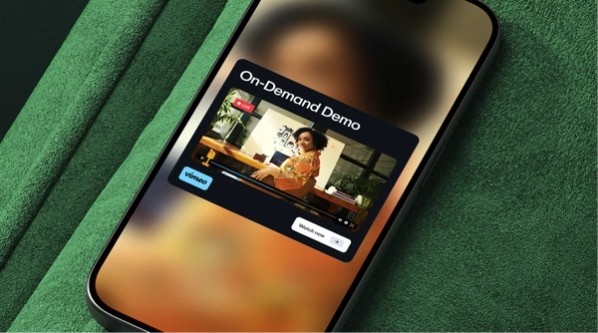
Hey Marketer: You’re Thinking About UGC Content All Wrong
Published 19 Oct, 2023
User-generated content (UGC) is a powerful marketing tool that relies on authentic content from users or seemingly non-affiliated sources. Many markets misunderstand or undervalue UGC content's utility, and miss out on the chance to enhance their marketing efforts.
With the possible exception of marketers themselves, nobody likes feeling marketed to. The QA department in your brain flags every obvious ad, and vows to take what follows with a grain—no, a slab—of salt. However great the product or service, you know that marketing is still more concerned with your dollar than your happiness.
That’s why the best marketing never comes from marketers. The trust we place in seemingly-unaffiliated strangers is why we visit Reddit before making a big purchase, and why user-generated content (“UGC” or “UGC content”) has been blowing up in recent years.
It is not, at first glance, marketing. And since that first glance is where most of us make the decision to keep watching, reading or scrolling, marketing that offsets the audience's unease is operating leagues above the competition.
And yet, only 29.7% of brands are pursuing UGC video right now. So why are so many marketers still uneasy about trying it?
Simple. They don’t understand it.
What Is User-Generated Content, Really?
Depends who you ask. The classic definition of user-generated content comes from social and video sharing platforms like YouTube and Facebook (arguably even earlier iterations like forums and wikis), where the point of the platform is to engage with the content created by each unique user. Videos, images, text, audio… anything a user unrelated to the site posts is content, and constitutes user-generated content.
Under the classic definition, marketing with UGC content is reliant on users openly sharing positive sentiment towards your brand independent of you incentivizing them with things like money or access.
How modern marketing uses UGC
Since hoping and waiting for positive brand sentiment isn’t something most marketers are comfortable with, a wider definition is more useful.
In marketing, UGC content could be seen as any content promoting the brand that is not, at first glance, coming from the brand itself. In the modern market, this takes the form of brands hiring content creators to review and/or talk about the brand (often giving free access to the service or products to do so), or having employees appear in “UGC style” ads that mimic the unbiased nature of organic, non-incentivized UGC.
Is it sneaky? Of course.
Does it work? You bet. Welcome to marketing.
Why UGC Works for B2B and B2C
As with all things perceived as “hot” and “new”, there’s an assumption that UGC is only for the B2C world.
But this is how it always is. B2C adopts some clever new way of marketing to their comparatively huge base en masse, and B2B disregards it until it becomes the norm. It happened with Buzzfeed/listicles, it happened with video marketing, and it’ll keep happening until the sun explodes.
It’s not totally unreasonable. For one, a business’ decision making process is at least 50 times longer than that of the average consumer—it’s tough to imagine a snippy, typically-lower-quality video compelling a prospective business to book a call. That sort of thing might impress the average user, but it’s surely less likely to motivate a whole team.
For an example of such snippy, lower-production video, have a look at this high-performer below!
The benefits of UGC in B2B Marketing
Businesses are comprised of people. Earth-shattering stuff, I know. The people that make big scale decisions are just as impressionable; just as subject to the emotional appeal of an apparently unbiased stranger weighing in on what you’re selling. It won’t be the only tool for driving a business target down funnel, but tempering their skepticism right out of the gate is a damn good starting point.
To see how B2B brands can use UGC content to up their marketing game (and their results), peek our Gather & Grow with Rugless' Eliz Hiz.
Here’s why UGC marketing is more useful than B2B gives it credit for:
UGC content implies authenticity. UGC carries a high level of authenticity and trust. When B2B customers see their peers or other professionals endorsing a product or service, it can boost their confidence in the offering. By using paid UGC, B2B companies can ensure that the content aligns with their message and brand while maintaining the trustworthiness associated with user-generated content.
UGC content bolsters existing content with variety. B2B marketing often requires diverse content to cater to different stages of the buying cycle. Paid UGC campaigns can generate a range of content types, from case studies and testimonials to video reviews and social media endorsements. This variety allows B2B companies to address the informational needs of their prospects effectively.
UGC content humanizes the brand. UGC can humanize a brand, making them more relatable and approachable. Paid UGC campaigns, for instance, can showcase the people behind the company, sharing their stories and experiences. This human element can establish a more personal connection with the audience, which is essential in B2B where relationships play a significant role.
Want to know why this more "human" approach works for marketers? Let our video wizard Kyle tell you below.
UGC content amplifies reach when paired with paid strategies. Paid UGC allows B2B companies to amplify their reach and target specific audiences. By promoting user-generated content through advertising, companies can ensure it reaches a wider, yet still highly targeted, audience. This can be especially beneficial when trying to expand into new markets or industries.
UGC content affords access to influencer audiences. B2B influencers are individuals with authority and expertise in specific niches. They can create valuable UGC, and paid partnerships with these influencers can further enhance a company's reputation and reach. Influencer-generated content is often trusted by B2B decision-makers, making it a valuable addition to marketing strategies.
UGC content boosts SEO. Paid UGC can also contribute to SEO efforts. When users create content that includes relevant keywords and backlinks to the company's website, it can improve search engine rankings. This content, when properly optimized, can draw organic traffic and enhance the company's online visibility.
UGC content stands out (when you want to). B2B markets can be highly competitive, and staying ahead requires innovation in marketing strategies. Paid UGC can offer a competitive advantage by demonstrating that the company is actively engaging with its customers and the industry, thus signaling a commitment to excellence and responsiveness.
UGC content blends in (when you want to). As we’ve found in our own marketing with UGC, the format can help B2B marketing blend into spaces where marketing efforts are normally shunned or greeted with hesitation (i.e. YouTube, TikTok, IG). Planting a flag where others don’t dare tread can be useful.
UGC content is measurable. Paid UGC campaigns provide a clear ROI. B2B companies can track engagement, conversion rates, and revenue generated through these campaigns. This data-driven approach allows for better decision-making and optimization of existing marketing strategies.
Types of UGC Content: Organic & Paid
As mentioned earlier, there are two avenues when it comes to marketing with UGC: Organic (unpaid), and paid (paid). And frankly, it can be hard to tell them apart from a consumer’s/business’ perspective.
Organic UGC is non-incentivized, and takes the form of videos, graphics, expert posts and other media, usually posted to the big social and content platforms by users and content creators. Though inspired by some experience with your product or service, they’re not doing it for you. Most often, they’re doing it for their peers or audience, and to build up their own brand as one who makes trustworthy content about such things.
See Jasper's "superfans" below for a striking example!
Paid UGC is incentivized, most often in the form of product/service access and money. It can take the form of any of the above, though it’s most familiar and obvious in the form of testimonials, reviews and other product-forward content. It’s most often posted by content creators, influencers, and even the brand itself in the form of less official-looking UGC style ads. The latter frequently stars employees of the company, who may not immediately read as being an arm of the brand.
The lack of clear distinction between the two is one reason marketers are increasingly fond of UGC-style content. To the target, it just scans as normal content. Maybe a bit salesy, but not so much as to stop engaging.
We found it out ourselves with this low-budget, paid UGC ad directing prospects to our "Design Dysfunctions" guide.
👉Get the playbook on how to score 1,200 leads in one month with UGC video
Examples of UGC Marketing
UGC isn’t the stranger marketers make it out to be. Plenty of high-performing businesses have tried their hands at user-generated marketing, typically with a great degree of success. Below are a few notable instances of UGC marketing in the B2B and B2C realm.
1. Salesforce’s UGC-Style Education Shorts & Reels
Salesforce, a global leader in CRM software, understands the power of edu-tainment. Instagram's reels and YouTube's shorts are an easy way to connect with users who like their content to get to the point. Salesforce have made UGC-style shorts and reels a staple in their marketing plan, most often featuring senior/executive level employees chiming in on topics important to the brand.
2. GoPro’s #GoProAwards
On the more polished side of UGC, GoPro's "GoPro Awards" campaign encouraged users to submit their exciting GoPro-captured moments. Users could earn monetary rewards for their submissions, often ranging from epic adventures to heartwarming family experiences.
This mix of paid incentives and organic UGC helped GoPro gather a wealth of high-quality content, showcasing the versatility of their products. The UGC was then featured in various marketing materials, including social media, website galleries, and advertisements.
3. Suzanne Kalan’s UGC-Style Social Ads
Luxury jeweler Suzanne Kalan aimed to reach Gen Z daughters and Gen X mothers on Mother’s Day. A TikTok presence was mandatory to reach the former, and they didn’t have a way to break through without seeming like yet another brand embarrassing itself in front of the zoomers.
Using Superside to supercharge their creative marketing capacity, the brand successfully (and quickly) pumped out three heroes, six teasers and nine product videos perfectly mirroring the high-quality-but-approachable UGC content their audience connects with most.
4. Hootsuite's "#IWorkFromHere" Campaign
UGC doesn't have to require a lot of legwork, as social media management platform Hootsuite know well. Their "#IWorkFromHere" campaign called on their clients to share images and brief stories about their remote lifestyles—lifestyles made easier with the simplicity and automation the platform provides.
Offering merchandise and other prizes to new winners each week, Hootsuite needed only to reshare the posts for easy publicity and access to their users' audiences. By the end of the campaign, the number of UGC posts had reached the thousands.
5. Curative’s “FAQ” Videos
A leading healthcare company with a unique employer-based health insurance plan, Curative had a lot of questions to answer from their health-conscious audience. To answer these questions in a way that wouldn’t come across as too promotional, their marketing team tagged Superside to create UGC style content that highlighted the brand’s offer in a funny, relatable way.
Scaling UGC with Creative-as-a-Service (CaaS)
In a dynamic and highly competitive digital landscape, user-generated content is a game-changer for marketers. It builds trust, while engaging your audience on a more personal level—ultimately driving funnel movement and conversions.
Generating UGC-style content at scale while maintaining authenticity and cost-efficiency is no small task, of course. Superside's always around to help you with video production of all kinds, so don't hesitate to reach out if you need a hand.
David is a Senior Content Marketer at Superside. A former journalist with bylines too numerous to enumerate, he brings his love of storytelling and semantics to the marketing world. Recognizing the sizable gaps in the creative-as-a-service (CaaS) sector, he jumped at the chance to fill the creative void for ambitious brands. In his off hours, he enjoys loud music, making vegan meals and being made fun of for making vegan meals. He’ll gladly talk to you about any of the above on LinkedIn.













